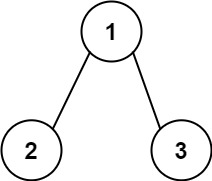Given the root of a binary tree and an integer targetSum, return true if the tree has a root-to-leaf path such that adding up all the values along the path equals targetSum.
A leaf is a node with no children.
Example 1:

Input: root = [5,4,8,11,null,13,4,7,2,null,null,null,1], targetSum = 22
Output: true
Explanation: The root-to-leaf path with the target sum is shown.
Example 2:

Input: root = [1,2,3], targetSum = 5
Output: false
Explanation: There two root-to-leaf paths in the tree:
(1 --> 2): The sum is 3.
(1 --> 3): The sum is 4.
There is no root-to-leaf path with sum = 5.
Example 3:
Input: root = [], targetSum = 0
Output: false
Explanation: Since the tree is empty, there are no root-to-leaf paths.
Constraints:
- The number of nodes in the tree is in the range [0, 5000].
- -1000 <= Node.val <= 1000
- -1000 <= targetSum <= 1000
Java Completions:
/**
* 递归实现
*/
class Solution {
public boolean hasPathSum(TreeNode root, int targetSum) {
if (root == null) return false;
if (root != null && root.left == null && root.right == null && targetSum == root.val) return true;
int new_target = targetSum - root.val;
return hasPathSum(root.left, new_target) || hasPathSum(root.right, new_target);
}
}
/**
* 非递归实现
*/
class Solution {
public boolean hasPathSum(TreeNode root, int targetSum) {
if (root == null) return false;
Stack<TreeNode> tree = new Stack<>();
Stack<Integer> val = new Stack<>();
tree.push(root);
val.push(root.val);
while (!tree.isEmpty()) {
TreeNode pop = tree.pop();
Integer popVal = val.pop();
if (pop.left == null && pop.right == null && popVal == targetSum) return true;
if (pop.left != null) {
tree.push(pop.left);
val.push(popVal + pop.left.val);
}
if (pop.right != null) {
tree.push(pop.right);
val.push(popVal + pop.right.val);
}
}
return false;
}
}
























 663
663

 被折叠的 条评论
为什么被折叠?
被折叠的 条评论
为什么被折叠?








